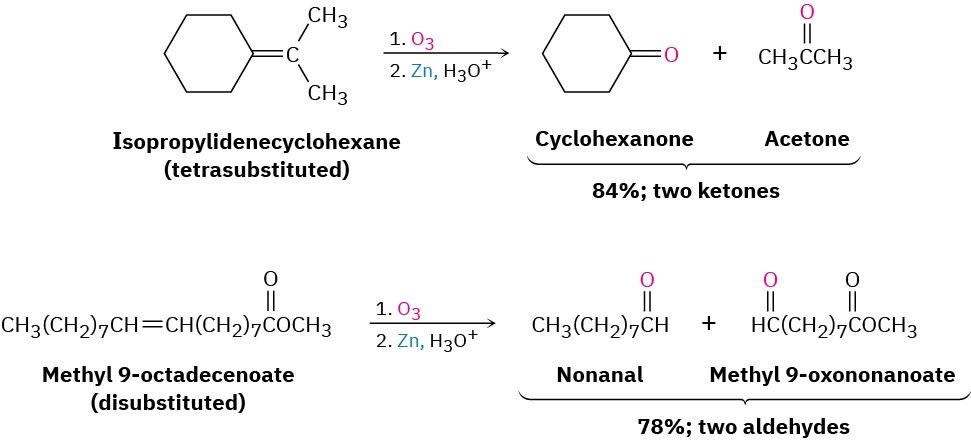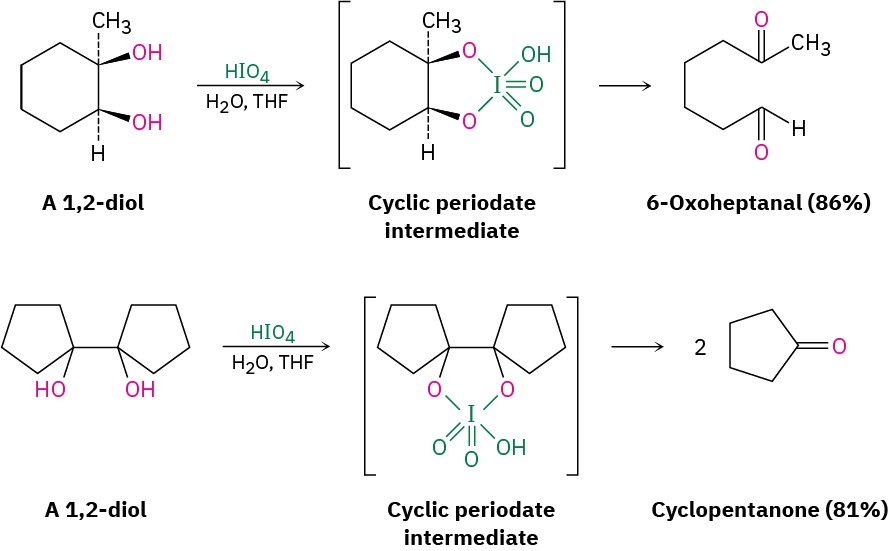8.8 Oxidation of Alkenes: Cleavage to Carbonyl Compounds
In all the alkene addition reactions we’ve seen thus far, the carbon–carbon double bond has been converted into a single bond but the carbon skeleton has been unchanged. There are, however, powerful oxidizing reagents that will cleave C═C bonds and produce two carbonyl-containing fragments.
Ozone (O3) is perhaps the most useful double-bond cleavage reagent. Prepared by passing a stream of oxygen through a high-voltage electrical discharge, ozone adds rapidly to a C═C bond at low temperature to give a cyclic intermediate called a molozonide. Once formed, the molozonide spontaneously rearranges to form an ozonide. Although we won’t study the mechanism of this rearrangement in detail, it involves the molozonide coming apart into two fragments that then recombine in a different way.

Low-molecular-weight ozonides are explosive and therefore not isolated. Instead, the ozonide is immediately treated with a reducing agent, such as zinc metal in acetic acid, to produce carbonyl compounds. The net result of the ozonolysis/reduction sequence is that the C═C bond is cleaved and an oxygen atom becomes doubly bonded to each of the original alkene carbons. If an alkene with a tetrasubstituted double bond is ozonized, two ketone fragments result; if an alkene with a trisubstituted double bond is ozonized, one ketone and one aldehyde result; and so on.

Several oxidizing reagents other than ozone also cause double-bond cleavage, although such reactions are not often used. For example, potassium permanganate (KMnO4) in neutral or acidic solution cleaves alkenes to give carbonyl-containing products. If
hydrogens are present on the double bond, carboxylic acids are produced; if two hydrogens are present on one carbon, CO2 is formed.

In addition to direct cleavage with ozone or KMnO4, an alkene can also be cleaved in a two- step process by initial hydroxylation to a 1,2-diol, as discussed in the previous section, followed by treatment of the diol with periodic acid, HIO4. If the two −OH groups are in an open chain, two carbonyl compounds result. If the two −OH groups are on a ring, a single, open-chain dicarbonyl compound is formed. As indicated in the following examples, the cleavage reaction takes place through a cyclic periodate intermediate.
 Worked Example 8.3Predicting the Reactant in an Ozonolysis ReactionWhat alkene would yield a mixture of cyclopentanone and propanal on treatment with ozone followed by reduction with zinc?
Worked Example 8.3Predicting the Reactant in an Ozonolysis ReactionWhat alkene would yield a mixture of cyclopentanone and propanal on treatment with ozone followed by reduction with zinc?
 StrategyReaction of an alkene with ozone, followed by reduction with zinc, cleaves the C=C bond and becomes two C=O bonds. Working backward from the carbonyl-containing products, the alkene precursor can be found by removing the oxygen from each product and joining the two carbon atoms.
StrategyReaction of an alkene with ozone, followed by reduction with zinc, cleaves the C=C bond and becomes two C=O bonds. Working backward from the carbonyl-containing products, the alkene precursor can be found by removing the oxygen from each product and joining the two carbon atoms.
 Solution
Solution
Problem 8-15
What products would you expect from reaction of 1-methylcyclohexene with the following reagents?
(a)
Aqueous acidic KMnO4 (b)
O3, followed by Zn, CH3CO2H Problem 8-16
Propose structures for alkenes that yield the following products on reaction with ozone followed by treatment with Zn:
(a)
(CH3)2C=O + H2C=O
(b)
2 equiv CH3CH2CH=O

